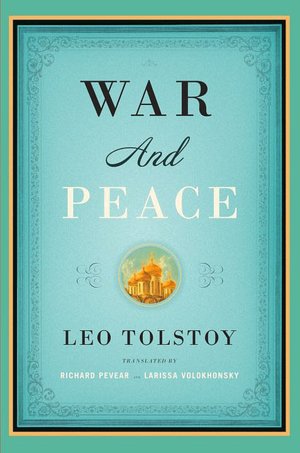War and Peace (Pevear/Volokhonsky Translation). Leo Tolstoy

War-and-Peace-Pevear-Volokhonsky.pdf
ISBN: 9781400079988 | 1296 pages | 22 Mb

- War and Peace (Pevear/Volokhonsky Translation)
- Leo Tolstoy
- Page: 1296
- Format: pdf, ePub, fb2, mobi
- ISBN: 9781400079988
- Publisher: Knopf Doubleday Publishing Group
Free ebooks to download in pdf War and Peace (Pevear/Volokhonsky Translation) 9781400079988 by Leo Tolstoy iBook ePub
From the award-winning translators of Anna Karenina and The Brothers Karamazov comes this magnificent new translation of Tolstoy's masterwork. War and Peace broadly focuses on Napoleon’s invasion of Russia in 1812 and follows three of the most well-known characters in literature: Pierre Bezukhov, the illegitimate son of a count who is fighting for his inheritance and yearning for spiritual fulfillment; Prince Andrei Bolkonsky, who leaves his family behind to fight in the war against Napoleon; and Natasha Rostov, the beautiful young daughter of a nobleman who intrigues both men. A s Napoleon’s army invades, Tolstoy brilliantly follows characters from diverse backgrounds—peasants and nobility, civilians and soldiers—as they struggle with the problems unique to their era, their history, and their culture. And as the novel progresses, these characters transcend their specificity, becoming some of the most moving—and human—figures in world literature. An essay on translating WAR AND PEACE by Richard Pevear To many prospective readers Tolstoy's War and Peace is the most intimidating of literary monuments. It is there, like a vast, unexplored continent, and all sorts of daunting rumors circulate about life in the interior. But once you cross the border, you discover that the world of War and Peace is more familiar and at the same time more surprising than the rumors suggested. That is as true for the translator as it is for the first-time reader. We spent three years working full-time on the translation, revising it, copy-editing it, proofreading it twice, meaning that each of us read the novel some five times in Russian and in English. Yet even in my final checking of the proofs, I still found myself delighting, laughing, or holding back my tears as I read. An example of this last is the moment near the end when Pierre and Natasha, after all the harrowing experiences they've lived through, finally meet again in Princess Marya's drawing room. Pierre sees that Princess Marya has someone with her, but doesn't realize who it is. Princess Marya is perplexed. She again shifted her gaze from Pierre's face to the face of the lady in the black dress and said: "Don't you recognize her?" Pierre glanced once more at the pale, fine face of the companion, with its dark eyes and strange mouth. Something dear, long forgotten, and more than sweet looked at him from those attentive eyes. "But no, it can't be," he thought. "This stern, thin, pale, aged face? It can't be her. It's only a reminiscence of that one." But just then Princess Marya said: "Natasha." And the face, with its attentive eyes, with difficulty, with effort, like a rusty door opening – smiled, and from that open door there suddenly breathed and poured out upon Pierre that long-forgotten happiness of which, especially now, he was not even thinking. It breathed out, enveloped, and swallowed him whole. When she smiled, there could no longer be any doubt: it was Natasha, and he loved her. What makes this passage so moving is not only the drama of the moment itself, but the way Tolstoy has sensed it and captured it in words. It can't be paraphrased; the translator has to follow as closely as possible the exact sequence and pacing of the words in order to catch the "musical" meaning of the original, which is less apparent than the "literal" meaning, but alone creates the impression Tolstoy intended. I've said "translator," and in a sense our collaboration is so close that the two of us make up one translator who has the luck to be a native speaker of two languages. That situation has its advantages. Translators are always in danger of drifting into the sort of language that is commonly referred to as "smooth," "natural," or, as they now say, "reader friendly," and is really only a tissue of ready-made phrases. When that happens to me, as it sometimes does, Larissa is there to stop me. Where I have my say is in judging the quality of our English text, that is, in drawing the line between a literal and a faithful rendering, which are not at all the same. If the translation does not finally "work" in English, it doesn't work at all. I'll take an example of what that collaboration can produce from Tolstoy's description of the Russian army crossing the river Enns. After a good deal of confusion, the hussar captain Denisov finally manages to clear the infantry from the bridge and send his cavalry over. As the first riders move onto the bridge, Tolstoy writes: "On the planks of the bridge the transparent sounds of hoofs rang out . . ." The Russian is unmistakable—prozrachnye zvuki "transparent sounds"—and I find its precision breathtaking. It is pure Tolstoy. To my knowledge, it has never been translated into English. What we find in other versions is the "thud" or "clang" of hoofs, and it is likely that I would have done something similar if Larissa had not brought me back to what Tolstoy actually wrote. His prose is full of such moments. Coming upon them and finding words for them in English has been one of the most rewarding aspects of our work. Here is a very different and rather amusing example of the search for fidelity. Count Ilya Andreich Rostov, Natasha's father, is giving a banquet in honor of General Bagration. Ordering the menu, he insists that "grebeshki" be put in the "tortue." I assumed that tortue was French turtle soup, but what about grebeshki? The Russian word can mean either "cock's-combs" or "scallops." Which would you put in a turtle soup? I did research into the uses of cock's-combs, but with rather unappealing results. I looked at previous translations: one has "scallops" and thinks the soup is a "pie crust"; another has "cock's-combs" but in a "pasty"; in a third the "cock's-combs" are in a "soup"; the fourth agrees about the soup, but puts "croutons" in it. Going by my own taste, I decided to put scallops in the turtle soup. This reading got as far as the first set of page proofs. Just then we met by chance (at a dinner in Paris) a woman who used to run a cooking school. We asked her which it should be. She, too, was puzzled. A few days later we received a long email from her. She had become so intrigued by our question that she went to the French National Library the next day and looked up the history of the culinary use of cock's-combs. She was happy to inform us that they came into fashion precisely around the time of the Napoleonic wars and were a key ingredient in turtle sauce. Suddenly the whole passage made sense, because the chef replies to the old count's order: "Three cold sauces, then?" The other translations have "three cold dishes" or "entrees," with no relation to sauces at all. Thanks to Mme. Meunier, we were able to make the correction in the second set of proofs. But does such a small thing really matter? Well, it certaintly did to Tolstoy. What this seemingly trivial detail reveals is the extraordinary accuracy of his memory, even in the smallest things. Cock's-combs had gone out of fashion by his time, but he knew where to place them and in what. Tolstoy's prose is a rich, fluid, multivoiced artistic medium. There is, for instance, a war between the French and Russian languages in War and Peace that mirrors the war between the French and Russian armies. His play with French and with gallicized Russian is a major element of social satire in the novel's composition, allowing him the sort of linguistic infiltrations later found in Joyce and Nabokov. This adds a verbal dimension to War and Peace that English readers don't suspect is there, because previous English translations have eliminated it. But this precocious modernism is never word play for its own sake. It is always moved by passion. The world of War and Peace envelops you. It is full of uncertainties, surprises, constantly shifting perspectives, but once you enter it you feel that you're in sure hands. Over it all is that "infinite sky" that Prince Andrei discovers as he lies wounded on the field of Austerlitz. This vast unity that embraces the greatest diversity is the secret, the mystery, of Tolstoy's art. It presents a great challenge to its translators, as I've tried to suggest in a small way.
In Translation: Richard Pevear and Larissa Volokhonsky
Richard Pevear and Larissa Volokhonsky are the translating dream team. Husband and wife ever be better than the original. war-and-peace
The Pevear/Volokhonsky Hype Machine and How It Could Have
I have no idea how Richard Pevear and Larissa Volokhonsky's translation of The Brothers Karamazov came to be regarded as definitive.
The Claremont Institute - Puritans and Cavaliers
Cavaliers translate freely; puritans stress fidelity to the text. Richard Pevear and Larissa Volokhonsky, the newest translators of War and Peace,
Tolstoy lives - Analysis - DNA
Two years ago I read a fresh translation by the couple Richard Pevear and Larissa Volokhonsky of Leo Tolstoy's epic War and Peace.
Fishko Files: War and Peace - WNYC
Purchase your copy of Richard Pevear and Larissa Volokhonsky's new translation of Leo Tolstoy's War and Peace and King Vidor's slight but
Richard Pevear and Larissa Volokhonsky - Wikipedia, the free
1 Richard Pevear; 2 Larissa Volokhonsky; 3 Collaboration; 4 Bibliography; 5 Notes . Their translation of Leo Tolstoy's War and Peace was published on 16
Michael Wood reviews 'War and Peace' by Leo Tolstoy, translated
War and Peace by Leo Tolstoy, translated by Richard Pevear and Larissa . ' Thought she felt' is downright surgical, and Pevear and Volokhonsky are not at all
Tolstoy's “War and Peace” in 2010 | The Longest Chapter
What sets the Pevear and Volokhonsky translation apart is their absolute fidelity to I read War and Peace years ago and guess what? I don't
Richard Pevear and Larissa Volokhonsky on "War and Peace" | To
Richard Pevear and Larissa Volokhonsky on "War and Peace" husband and wife team who've translated many of the great Russian writers.
On Garnett, Pevear and Volokhonsky, etc. | Steve Reads
Garnett went nearly blind working on “War and Peace. . To compare the Garnett and the Pevear-Volokhonsky translations of “The Brothers
Tolstoy's War and Peace: comments on the Volokhonsky,/Pevear
the programme to Tolstoy's War and Peace, specifically to the new Volokhonsky-Pevear translation. For those interested in the novel or in the
Archive, August 2006 - Language Geek
All these editions of War and Peace are really starting to pile up on my shelves. And now I'll have to get the Pevear & Volokhonsky translation
The Millions Interview: Richard Pevear and Larissa Volokhonsky
After reading their 2007 translation of War and Peace, Orlando great works of Russian literature, Pevear and Volokhonsky are something of a
Download more ebooks:
Online Read Ebook Star Wars, Dark Vador - Le seigneur noir des Sith Tome 1
LA BELLA BESTIA leer epub gratis
Download PDF Metasploit - Testez la sécurité de vos infrastructures
MEDIA HORA MAS CONTIGO JANE RULE ePub gratis
[ePub] DÉFI 3 - LIVRE DE L ÉLEVE + CD (B1) EDITION PREMIUM descargar gratis
0コメント